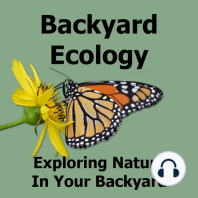57 min listen
Conserving our Southeastern Grasslands with Dwayne Estes
FromBackyard Ecology
ratings:
Length:
54 minutes
Released:
Jan 7, 2021
Format:
Podcast episode
Description
Many of us grew up hearing about the decline of the old growth forests and their impacts on neotropical songbirds and other wildlife. I think this was especially true for those of us who grew up here in the eastern U.S. However, the story that hasn’t been told as well is that of the southeastern grasslands and how they have declined. Yes, I said “southeastern grasslands” because historically, much of the southeast was a diverse patchwork of grassland communities, not a continuous forest like it has often been portrayed. On today’s episode of Backyard Ecology, we talk with Dwayne Estes, Executive Director of the Southeastern Grasslands Initiative (SGI). SGI works in a region that basically covers from Columbia, MO across to Long Island, NY, down to Miami, FL and back across to Brownsville, TX. Even though New York and some of these other areas aren’t what we traditionally think of as part of the southeast, all of these areas have very similar grasslands. In addition to his work with SGI, Dwayne is also a Professor of Biology in the Center of Excellence for Field Biology, Austin Peay State University. As Dwayne tells us, it has only been within the last decade or so that we’ve begun to realize just how diverse our southeastern grasslands were. Despite the fact that most of us probably think of Kansas and the Great Plains when we hear the term “grasslands,” the southeastern U.S. actually has more types of grasslands than the entire Great Plains of the U.S. and Canada combined. All these different types of southeastern grasslands also translate to a greater biodiversity of animals than can be found in Great Plains. Scientists now think that approximately half of all the plants and animals in the eastern U.S. are tied to grasslands. Part of this biodiversity stems from the fact that not all animals like the same types of grasslands – some species like short grass, some like tall grass, some need larger tracts, some are happy on smaller acreages, some like drier areas, and some are drawn to wetter areas. By having so many different types of southeastern grasslands, there are opportunities for all of these different habitat preferences to be met. And just to be clear, when we talk about southeastern grasslands, we aren’t talking about mowed yards. We’re talking about short-grass prairies, tall grass prairies, savannahs, glades, wet prairies, coastal plains, and other similar locations where native grasses and their associated wildflowers are the dominant vegetation. Trees and shrubs can exist in those areas too, as in the case of savannahs, but they aren’t the dominant vegetation type like you see in a forest setting. Nowadays, it can be hard to find naturally occurring southeastern grasslands because many of our southeastern grasslands have been turned into agricultural lands (croplands or pastures) or allowed to grow up into forests after fire was removed from the ecosystem. Some of the best places to look for existing southeastern grassland remnants are often in powerline rights-of-ways, along rocky roadsides, along old fence rows, or in similar places. It is entirely possible for someone to have a southeastern grassland remnant on their property and not even realize it. Most of our remaining southeastern grasslands have been reduced to only a few acres and are located on private land which makes small landowners critical in identifying, managing, and helping to conserve our southeastern grasslands. Larger tracts of southeastern grasslands still exist in a few places, but they are much less common than the smaller grasslands. The Southeastern Grasslands Initiative is working to raise awareness of our southeastern grasslands and to provide science-based resources for identifying, managing, and conserving those habitats. They are accomplishing this by partnering with many different conservation and educational organizations and agencies, as well as, with individuals who are just interested in southeastern grasslands an
Released:
Jan 7, 2021
Format:
Podcast episode
Titles in the series (92)
Growing Native Plants in Small Yards: Growing Native Plants by Backyard Ecology
